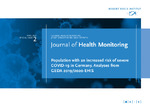Population with an increased risk of severe COVID-19 in Germany.
Analyses from GEDA 2019/2020-EHIS
Rommel, Alexander
von der Lippe, Elena
Treskova-Schwarzbach, Marina
Scholz, Stefan
Only a minority of people who test positive for COVID-19 develop a severe or critical form of the disease. Many of these have risk factors such as old age or pre-existing conditions and, therefore, are at the focus of protective measures. This article determines the number of people at risk in Germany and differentiates them according to age, sex, education, household type and federal state. The analyses presented here are based on data from the German Health Update (GEDA) 2019/2020-EHIS, which was carried out as a nationwide cross-sectional telephone-based survey between April 2019 and October 2020. The definition of being at increased risk of severe COVID-19 is primarily based on a respondent’s age and the presence of pre-existing conditions. Around 36.5 million people in Germany are at an increased risk of developing severe COVID-19. Of these, 21.6 million belong to the high-risk group. An above-average number of people at risk live alone. The prevalence of an increased risk is higher among middle-aged men than among women of the same age, and significantly higher among people with a low level of education than among people with a high level of education. The highest proportion of people with an increased risk live in Saarland and in the eastern German federal states. When fighting the pandemic, it is important to account for the fact that more than half of the population aged 15 or over is at increased risk of severe illness. Moreover, the regional differences in risk burden should be taken into account when planning interventions.
Files in this item

